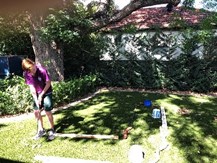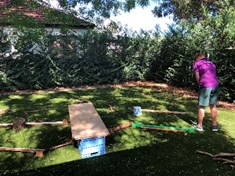 With learning being based in the home, it is important that students can still engage with learning that they have co-constructed. This activity of developing and designing an outdoor game demonstrates a student showing agency for their own learning, and being active and engaged socially with others, especially their family.
With learning being based in the home, it is important that students can still engage with learning that they have co-constructed. This activity of developing and designing an outdoor game demonstrates a student showing agency for their own learning, and being active and engaged socially with others, especially their family.
 The student began by generating ideas, producing game plans including diagrams and identifying items for construction. Use of common household items such as kitchen, cleaning and garden tools, recyclables and natural materials were considered as the plans were developed. Consideration of available space, prior knowledge of mini-golf courses, obstacle courses or marble runs and the use of technology to search unknown information were all part of the designing process. After construction and using the course, the student was asked to reflect upon the task and consider the successes, things that did not work and anything that could improve the game.
The student began by generating ideas, producing game plans including diagrams and identifying items for construction. Use of common household items such as kitchen, cleaning and garden tools, recyclables and natural materials were considered as the plans were developed. Consideration of available space, prior knowledge of mini-golf courses, obstacle courses or marble runs and the use of technology to search unknown information were all part of the designing process. After construction and using the course, the student was asked to reflect upon the task and consider the successes, things that did not work and anything that could improve the game.
“It was enjoyable to be able to explore my creativity, use different materials and it was satisfying to see the final result as I had imagined it.” Anthony, student
The learning experience of Anthony drew on several aspects of the Australian Curriculum and he was able to consolidate his learning and develop a range of skills in an interdisciplinary way.
|
Learning area |
Strand |
|
Key skills and learning |
|
Technologies: Design and Technologies |
Processes and production skills |
Creating design solutions by: generating and designing |
Generate, develop and communicate designs for a 9-hole mini- golf course |
|
|
|
Producing and Implementing |
Select appropriate materials and techniques to produce the designs |
|
|
|
Evaluating |
Review and revise the designs |
|
Mathematics: |
Number and algebra |
Number and place value |
Develop a scoring system (par) for each of the holes |
|
|
Measurement and geometry |
Using units of measurement |
Design holes with differing length |
|
|
|
Location and transformation |
Interpret the diagrams and identify the relative positions of the obstacles |
|
|
|
Geometric reasoning |
Identify angles used in the development of mini golf holes. |
|
HPE |
Focus areas: Active play and minor games, Games and sports |
Moving our body sub-strand: Refining movement skills and developing movement concepts and strategies
|
At each hole, practice your putting stroke and look to get the lowest score possible |
|
|
|
Learning through movement sub-strand: Critical and creative thinking in movement |
|
|
General capabilities |
Elements |
Sub-element |
|
|
Critical and Creative Thinking |
Inquiring, identifying, exploring and organising information and ideas |
Pose questions
Identify and clarify information and ideas
Organise and process information |
Explore mini-golf courses
Develop knowledge and understanding around the design of mini-golf course holes |
|
|
Generating ideas, possibilities and actions element |
Imagine possibilities and connect ideas
Consider alternatives
Seek solutions and put ideas into action |
Design and create a mini-golf course in your backyard |
|
|
Reflecting on thinking and processes element
|
Reflect on processes
Transfer knowledge into new contexts |
Use knowledge of mini-golf courses and draw connections to the backyard course
Reflect on choices |
|
|
Analysing, synthesising and evaluating reasoning and procedures element |
Draw conclusions and design a course of action
Evaluate procedures and outcomes
|
Look at problems from multiple perspectives, and modify plans when problems arise Use a range of resources
Evaluate the effectiveness of the design process |